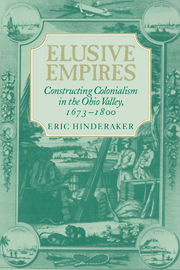Book contents
6 - Empire Ascendant
Published online by Cambridge University Press: 16 February 2010
Summary
At war's end national leaders hoped, above all, to rationalize and discipline the chaotic social forces of the Ohio Valley, to align their energies with the Revolutionary republican ideals that were being institutionalized in the seaboard states. But this was more easily envisioned than accomplished. The clarity and simplicity of nationalist blueprints for a new American empire came up against the complicated social patterns and tangled histories of settlers, Indians, traders, and British agents and officials who already occupied the region. As a result the goal of a rationalized and disciplined west was compromised. The political ascendancy of the United States, initially established in the region by the military support of revolutionary governments, was again extended in the 1780s and early 1790s by the force of arms, directed against the region's Indians in the interest of protecting western settlers. The United States Army succeeded in reshaping the Ohio Valley in ways policymakers could not.
The violent conflicts of the preceding decades indelibly stamped postwar culture. Even as they remained divided on a wide range of social and political questions, the Euroamerican residents of the Ohio Valley could unite in support of aggressive national expansion. Expansion was premised, in turn, on two theoretical innovations of the Revolutionary era: a territorial system that permitted Congress to extend national boundaries westward indefinitely, and a new definition of citizenship that was exceedingly generous toward Euroamericans but heightened the legal boundaries associated with race.
- Type
- Chapter
- Information
- Elusive EmpiresConstructing Colonialism in the Ohio Valley, 1673–1800, pp. 226 - 267Publisher: Cambridge University PressPrint publication year: 1997

